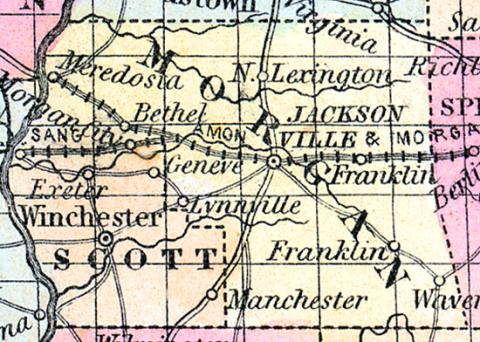MORGAN COUNTY, situated in the westerly part of Illinois, with Illinois river on the west. Area, 510 square miles. Seat of justice, Jacksonville. Pop. in 1830, 12,714; in 1840, 19,547; in 1850, 16,064. (Fanning's, 1853)
MORGAN COUNTY Is situated on the south-west central part of the state, and has an area of 530 square miles. It is partly bounded on the west by Illinois river and also drained by Apple, Sandy, Mauvaisterre and Indian creeks. The slope of the county is toward the west, the general surface is level. It consists of open plains, slightly undulating and intersperced with small growth of trees. The county is one of the most thickly settled and highly cultivated in the state. The soil is very deep, free from stones and of remarkable strength and durability. Corn, wheat, oats, hay, fruit, cattle and swine are the staples. In 1880 this county produced the largest amount of corn of any in the state except Sangamon. It contains about 60 churches, several newspaper offices, has over 2,000 pupils attending public schools, and about 500 attending academies and other institutions of learning. Peaches, apples and other fruits flourish in this region. Stone coal is found in abundance, supplying the place of wood as fuel. The Osage Orange, for hedges, is cultivated to a great extent and stretches for miles across the open prairies. The county is intersected by the Great Western railroad. A railroad is also being built, called the Jacksonville and Carrolton road, connecting the Illinois river at Peoria with the Mississippi at Alton. The state asylums for the deaf and dumb, the blind, and the insane are situated in this county. Capital, Jacksonville. Population, about 22,000. County Judge, Joseph J. Cassel. Sheriff, Chas. Sample. (Hawes' Illinois State Gazetteer...,1859)

